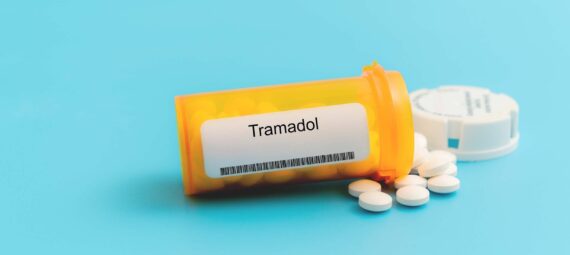What is Tramadol ?
Tramadol is a centrally acting opioid (Narcotic) analgesic drug used to treat moderate-to-severe pain. It belongs to a family of medicines known as ‘Narcotic Analgesics’. Tramadol is also one of the many prescription medications available in the form of ‘Immediate Release’ and ‘Extended Release’ formulations. However, there is also the possibility of taking this drug as an ‘Extended Release Capsule’.
Like any other ‘Opioid Agonists, ’ Tramadol works to alter your brain and changes the way the body responds to Pain. It does so through various biological targets. They are available on the opioid receptors, serotonergic, and noradrenergic systems.
It is available in the market in combination with paracetamol (acetaminophen). Tramadol is a medicine very popular with the brand name ‘Ultram’.
It received a patent in 1963 for the first time. 1977 was when the official launching of Tramadol under the name ‘Tramal’ first occurred. German pharmaceutical company Grünenthal was responsible for making this drug public. However, Tramadol only received approval for clinical use by the Food and Drug Administration or FDA of the United States of America (USA) and the United Kingdom during the mid-1990s. These days this drug is available as a ‘Generic medication’ worldwide. In 2020 Tramadol became the 35th most prescribed medicine in the USA.
How does Tramadol Tablet Work?
It is by exerting ‘Analgesic’ effects that Tramadol functions to help in the management of Pain. This medication is a racemic mixture containing positive and negative enantiomers (optical isomers) in equal amounts. That includes positive inhibiting serotonin reuptake and negative blocking noradrenaline reuptake. Also, these enantiomers of Tramadol are agonists of μ-opioid receptors (MOR) as well as M1 metabolite. Usually, when these work ‘Synergistically’ together, the ‘Analgesia’ effect is produced to help manage pain symptoms.
What are The Medical Uses of Tramadol Pills?
Typically, you use Tramadol (a Schedule IV drug in the USA) to manage symptoms of both acute and chronic Pain. There is slight evidence which suggests that you can use it for second-line treatment of ‘Fibromyalgia’. However, Tramadol has not yet received approval for clinical use in this disorder by the FDA thus far. In pain management, you can also use the medicine in combination with other ‘Opioid Agonist’ drugs.
How to Take Tramadol Tablet?
Are you keen to use Tramadol effectively to relieve your pain symptoms? If you are, you should learn to take it correctly. Therefore, here are a few tips on how to take Tramadol well.
- You must read the Medication Guide your pharmacist provides before taking a dose of Tramadol.
- Take this pain medication by mouth as instructed by your doctor every four to six hours on an as-needed basis.
- Also, it would help if you kept in mind that you can take Tramadol before or after your meal.
- Avoid trying to increase your dosage without consulting with your doctor. Since if you do so, then you may experience serious side effects that can lead to death
- It would help if you never stopped taking your Tramadol dose suddenly for no valid reason without consulting with your doctor, as doing so will result in serious, serious side effects.
- If you want to take this medicine in a solution form, then you need to use a syringe, measuring cup, or spoon to measure a dose accurately.
- Only use Tramadol if you are not suffering from drug allergy issues.
Dosage Schedule of Tramadol:
The dosing plan of Tramadol will depend on the type of Pain and the age of the individual taking this pain medicine. It is as follows:
Usual adult dosage for Acute Pain:
The minimum initial dose for an adult above the age of 17 years is 50 to 100 mg orally once a day every four to six hours on an as-needed basis for Pain.
Usual adult dosage for Chronic Pain:
Usually, when you are taking Tramadol for chronic Pain, you can take a dose of Extended Release (ER) or Immediate Release (IR) tablet as follows:
ER:
For 18 years or older only 100 mg orally once a day. The maximum dose is 300 mg/day. To increase the dose, you need to increase it by 100 mg every five days.
IR:
The initial minimum dosage is 100 mg orally one time a day. The maximum dosage is 300 mg/day.
Usual geriatric dosage for Acute Pain:
For adults above the age of 75 years, the initial minimum dosage via Immediate Release (IR) tablet is 300 mg per day. Also, you need to ensure that you select a dose carefully.
Usual geriatric dosage for Chronic Pain:
The initial minimum dosage of Tramadol administered via Immediate Release for adults above 75 is 300 mg daily.
Usual paediatric dosage for Pain:
Usually, you do not give Tramadol to children. Giving this drug to individuals above seventeen years and above is advisable.
Meanwhile, while taking Tramadol, there is a possibility that you may either miss a dose or overdose on it. In such situations, you need to take the following actions:
Missed dosage:
Since you use Tramadol for managing symptoms of Pain on an as-needed basis, there is less chance of you missing a dose. However, if you miss a dosage, you need to take it as soon as you remember, provided the time to take the second dose is not fast approaching.
Overdose:
When you overdose on Tramadol, there is a distinct possibility that you may experience a mix of mild side effects and serious side effects. Therefore, in such situations, you need to stop taking the medication and call your doctor immediately.
If you want to effectively use Tramadol and manage your pain symptoms, either acute or chronic, without experiencing side effects, then you need to know when not to take Tramadol. Here is presenting to you a few pointers explaining it:
When Not to Take Tramadol Tablet?
- If you are either prone to addiction or have suicidal thoughts, then you need to avoid taking this drug. Since Tramadol can trigger as well as worsen these conditions.
- If you have severe breathing problems like asthma, you need to stop taking Tramadol.
- It is advisable that you must not give this medication to a child who is below the age of 12, as doing so can lead to severe side effects and also prove to be fatal.
- A pregnant woman cannot take this medicine as it may cause adverse effects on the newborn child that may be life-threatening.
- Avoid consuming alcohol along with Tramadol, as it.
What are The Side Effects of Tramadol Tablets ?
When you take a synthetic drug like Tramadol, there is always a possibility that you may experience a mix of mild-to-severe side effects. They are as follows:
- Dizziness or drowsiness
- Headache
- Itching
- Constipation
- Tiredness
- Stomach pain
- Tiredness or fatigue
- Sleepiness
- Tightness of muscle
- Alteration in mood
- Nervousness
- Indigestion
Adverse-effects:
Please abandon taking a dosage of Tramadol immediately if you see the serious side effects mentioned below.
- Rash
- Hives
- Irregular heartbeat
- Hoarseness
- Seizures
- Consciousness loss
- Blister
- Swelling of eye, face, throat
- Noisy breathing
- Loss of appetite
- Lightheadedness
- Shallow breathing
- Tiredness or fatigue
Alternative Medicines:
In case you cannot take Tramadol because you can have drug allergy issues, then you can take the following medications given below instead:
Frequently Asked Questions:
Q. Is Tramadol effective in resolving Pain?
Tramadol is a medicine that acts directly on the opioid receptors in the central nervous system. Therefore, it does suppress the feeling of Pain in a very effective manner.
Q. Can Tramadol cause serious health issues?
When you take Tramadol, there is a possibility that you will experience serious breathing problems, especially occurring after the first 24 to 72 hours of consumption. Hence, while taking Tramadol, you need to ensure that you consult your doctor or pharmacist.
Q. How do you effectively store Tramadol?
If you want to preserve the effectiveness of Tramadol, then you need to store it well using the following storage guidelines. It is as follows:
- Try and keep Tramadol dosage as far as possible away from kids and pets.
- Never flush the unused medicine down your toilet drain. Always discard it using instructions from your pharmacist or waste disposal expert.
- Please store Tramadol in an airtight container away from light and heat under room temperature.
Find more at The Drug Info.

